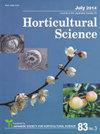Effect of Moderate Salinity Stress on the Sugar Concentration and Fruit Yield in Single-truss, High-density Tomato Production System
Journal of The Japanese Society for Horticultural Science
Pub Date : 2014-05-03
DOI:10.2503/JJSHS1.CH-096
引用次数: 18
Abstract
To produce tomato fruits with 6% average Brix without decreasing yield, we investigated the effect of moderate salinity stress on Brix and yield in a single-truss, high-density tomato production system. Because tomato fruit development can be predicted from cumulative temperature, we also assessed cumulative temperature after anthesis as a potential indicator for determining the starting points of salinity stress treatments. When transverse diameters of the first fruit reached 4 cm (i.e., early increase treatment) or the first fruits were at the mature green stage (i.e., late increase treatment), nutrient solution electrical conductivity was slowly increased until the breaker stage from 1.8 dS·m-1 to 6.0 dS·m-1. Plants subjected to the late increase treatment produced tomato fruits with Brix values of 6% without reductions in marketable yield. We also increased nutrient solution electrical conductivity based on cumulative temperature after anthesis and found that early-treated plants produced tomatoes with higher Brix levels and yields than late-treated plants. In summary, moderate salinity stress to avoid excessive stress on plants increased sugar concentrations without decreasing fruit yield and resulted in tomato fruits with average Brix of about 6% when nutrient solution electrical conductivity was increased at a rate of 0.1 dS·m-1·day-1. Because seasonal differences in cumulative temperature influence the appropriate timing of salinity stress applications, further study is needed to optimize year-round growth under moderate salinity stress in single truss, high-density tomato production systems.中盐胁迫对单架高密度番茄生产体系糖浓度及产量的影响
为了在不降低产量的情况下获得平均白糖度为6%的番茄果实,研究了中等盐度胁迫对单桁架高密度番茄生产体系白糖度和产量的影响。由于积温可以预测番茄果实的发育,我们还评估了花后积温作为确定盐胁迫处理起点的潜在指标。当初果横径达到4 cm时(即增早处理)或初果处于成熟青期时(即增晚处理),营养液电导率缓慢增加,直至破断期,由1.8 dS·m-1增加到6.0 dS·m-1。经晚增处理的植株所产的番茄果实糖度值为6%,但可销产量没有减少。我们还根据花后积温增加了营养液电导率,发现早处理植株比晚处理植株的白利度和产量更高。综上所述,当营养液电导率以0.1 dS·m-1·day-1的速率增加时,为避免对植株的过度胁迫,适度的盐胁迫提高了植株的糖浓度,但不降低果实产量,结果番茄果实的平均糖度约为6%。由于累积温度的季节差异会影响盐胁迫的适宜施用时间,因此需要进一步研究在单桁架高密度番茄生产系统中,在中等盐胁迫下优化全年生长。
本文章由计算机程序翻译,如有差异,请以英文原文为准。
求助全文
约1分钟内获得全文
求助全文
来源期刊
自引率
0.00%
发文量
0
审稿时长
>36 weeks

 求助内容:
求助内容: 应助结果提醒方式:
应助结果提醒方式:


